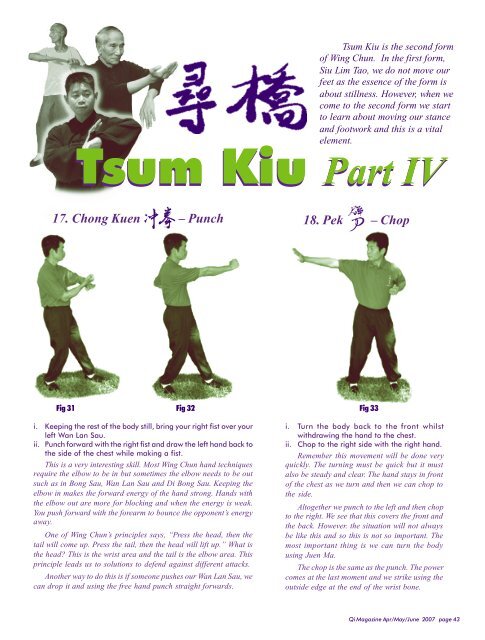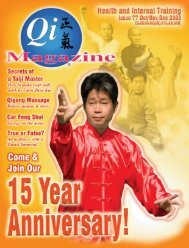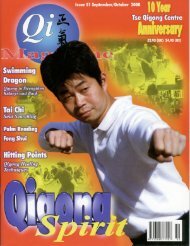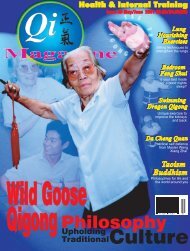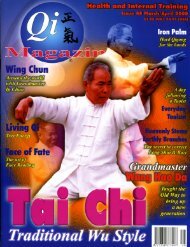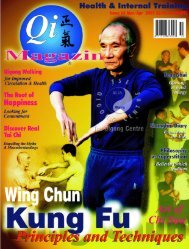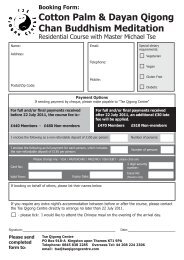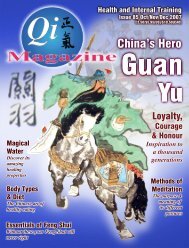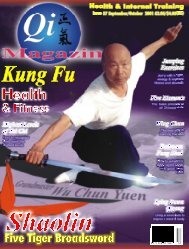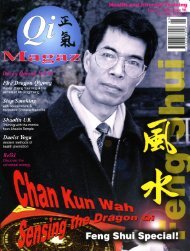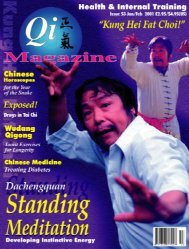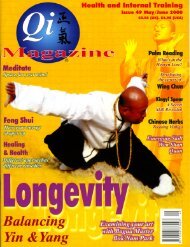You also want an ePaper? Increase the reach of your titles
YUMPU automatically turns print PDFs into web optimized ePapers that Google loves.
Tsum Kiu is the second form<br />
of Wing Chun. In the first form,<br />
Siu Lim Tao, we do not move our<br />
feet as the essence of the form is<br />
about stillness. However, when we<br />
come to the second form we start<br />
to learn about moving our stance<br />
and footwork and this is a vital<br />
element.<br />
Tsum Kiu Part IV<br />
17. Chong Kuen – Punch 18. Pek – Chop<br />
Fig 31 Fig 32 Fig 33<br />
i. Keeping the rest of the body still, bring your right fist over your<br />
left Wan Lan Sau.<br />
ii. Punch forward with the right fist and draw the left hand back to<br />
the side of the chest while making a fist.<br />
This is a very interesting skill. Most Wing Chun hand techniques<br />
require the elbow to be in but sometimes the elbow needs to be out<br />
such as in Bong Sau, Wan Lan Sau and Di Bong Sau. Keeping the<br />
elbow in makes the forward energy of the hand strong. Hands with<br />
the elbow out are more for blocking and when the energy is weak.<br />
You push forward with the forearm to bounce the opponent’s energy<br />
away.<br />
One of Wing Chun’s principles says, “Press the head, then the<br />
tail will come up. Press the tail, then the head will lift up.” What is<br />
the head? This is the wrist area and the tail is the elbow area. This<br />
principle leads us to solutions to defend against different attacks.<br />
Another way to do this is if someone pushes our Wan Lan Sau, we<br />
can drop it and using the free hand punch straight forwards.<br />
i. Turn the body back to the front whilst<br />
withdrawing the hand to the chest.<br />
ii. Chop to the right side with the right hand.<br />
Remember this movement will be done very<br />
quickly. The turning must be quick but it must<br />
also be steady and clear. The hand stays in front<br />
of the chest as we turn and then we can chop to<br />
the side.<br />
Altogether we punch to the left and then chop<br />
to the right. We see that this covers the front and<br />
the back. However. the situation will not always<br />
be like this and so this is not so important. The<br />
most important thing is we can turn the body<br />
using Juen Ma.<br />
The chop is the same as the punch. The power<br />
comes at the last moment and we strike using the<br />
outside edge at the end of the wrist bone.<br />
Qi Qi Magazine Apr/May/June 2007 page 43


